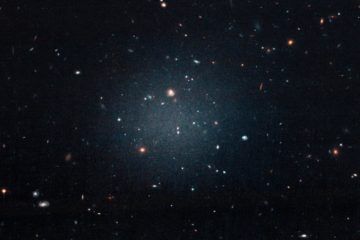Ethan Siegel in Forbes:
 Practically everywhere we look in the Universe, the large-scale objects that we see — small galaxies, large galaxies, groups and clusters of galaxies, and even the great cosmic web — all not only contain dark matter, but require it. Only in a Universe with far more mass than normal matter can provide, and in a different form from the protons, neutrons, and electrons that scatter and interact with themselves and with light, can our observations be explained. However, an interesting consequence should arise in a Universe with dark matter: the existence of a small but significant population of galaxies containing no dark matter at all.
Practically everywhere we look in the Universe, the large-scale objects that we see — small galaxies, large galaxies, groups and clusters of galaxies, and even the great cosmic web — all not only contain dark matter, but require it. Only in a Universe with far more mass than normal matter can provide, and in a different form from the protons, neutrons, and electrons that scatter and interact with themselves and with light, can our observations be explained. However, an interesting consequence should arise in a Universe with dark matter: the existence of a small but significant population of galaxies containing no dark matter at all.
For many years, these galaxies went undiscovered, providing ammunition to those ideologically opposed to the existence of dark matter. But in 2018, a team of researchers led by Pieter van Dokkum and Shany Danieli claimed to have discovered the first: a diffuse satellite galaxy of the large, nearby elliptical NGC 1052. The galaxy, NGC 1052-DF2, has been the subject of much scrutiny and debate, as the properties of this galaxy could help unlock the mysteries of the Universe’s dark side. With a new set of observations from Hubble, we not only have confirmed that his galaxy indeed has no dark matter, but we can finally fully explain what’s happening. Here’s the scientific story.
More here.
